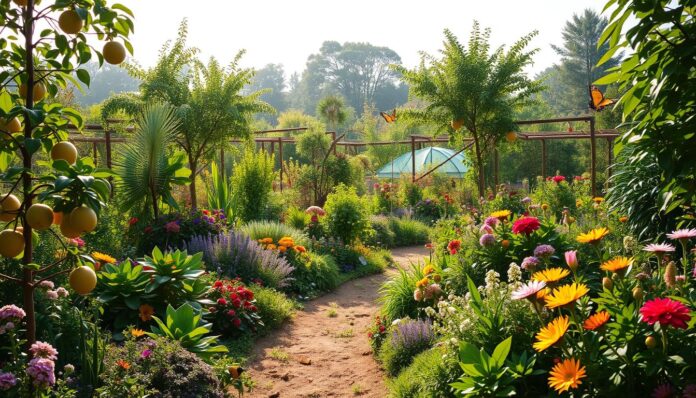When I first stepped into my small backyard garden, something remarkable happened. The soil beneath my fingers felt alive, connecting me to something deeper than my urban anxieties. This was my introduction to permaculture’s psychological benefits, a journey of healing through nature that transforms mental health and personal well-being.
Permaculture is more than gardening—it’s a holistic approach to understanding our relationship with nature and ourselves. Research shows compelling evidence of mental health and nature connections. Studies reveal up to a 30% reduction in anxiety and depression symptoms through engaging with permaculture practices.
Our modern world often disconnects us from natural rhythms, creating stress and emotional distance. Permaculture offers a scientifically-backed pathway to reconnect, providing therapeutic landscapes that nurture psychological resilience. By cultivating gardens and working with ecological systems, individuals can experience significant improvements in mood, self-esteem, and overall mental wellness.
Key Takeaways
- Permaculture practices can reduce anxiety and depression symptoms by up to 30%
- Gardening activities lower stress hormones and improve emotional regulation
- Working with nature increases serotonin production and emotional well-being
- Permaculture supports community connections and social engagement
- Natural environments provide therapeutic benefits for mental health
Understanding Permaculture and Its Principles
Permaculture is a new way to live sustainably, going beyond just gardening. It uses a design that has evolved with nature for over four billion years. This approach helps create systems that are good for the planet.
Definition of Permaculture
Bill Mollison and David Holmgren started permaculture in the 1970s in Australia. They combined ‘permanent’ and ‘agriculture’ to create it. Eco-therapy and permaculture share a bond, focusing on working with nature and living sustainably.
Core Principles of Permaculture
Permaculture is based on three main ethics:
- Care for the Planet
- Care for People
- Fair Share
Twelve guiding principles help make these ethics real:
- Observe and Interact
- Catch and Store Energy
- Obtain a Yield
- Apply Self-Regulation and Feedback
- Use and Value Renewables
Permaculture vs. Traditional Gardening
Permaculture is different from traditional gardening. It builds systems that grow back on their own, helping nature and reducing harm. Traditional gardening often uses up resources, but permaculture aims for integration and sustainability.
“Permaculture is a philosophy of working with, rather than against nature, of protracted and thoughtful observation rather than protracted and thoughtless labor.” – Bill Mollison
| Permaculture | Traditional Gardening |
|---|---|
| Holistic ecosystem approach | Linear production model |
| Minimal external inputs | High dependency on fertilizers |
| Promotes biodiversity | Often leads to monoculture |
| Low energy consumption | High energy requirement |
The Connection Between Nature and Mental Health
Humans have a deep connection to nature that greatly affects our mental health. Studies show that nature-based therapy and biophilic design are powerful tools for mental well-being.
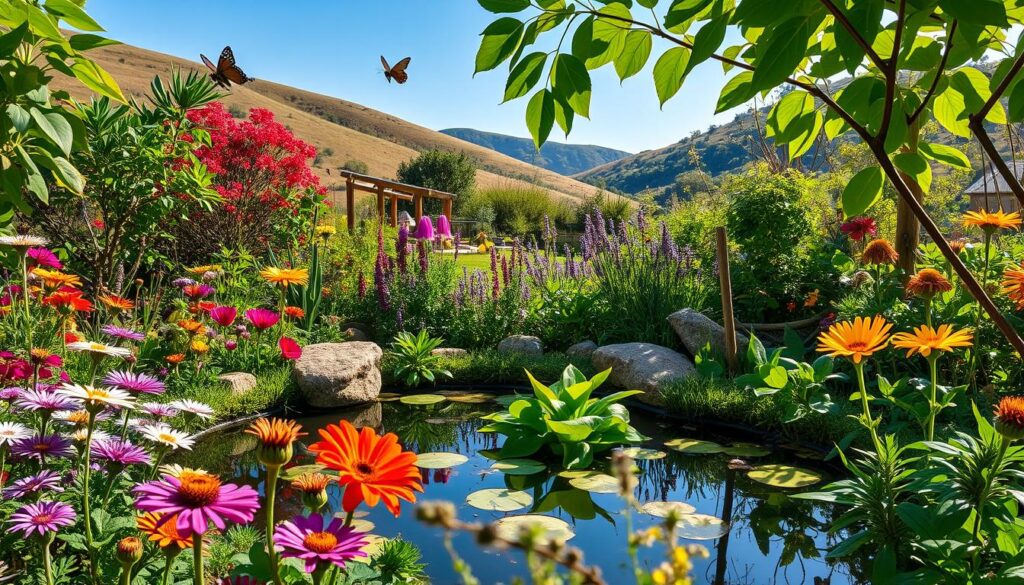
Nature’s Impact on Well-Being
Research proves that nature has amazing benefits for our minds. Being outside can:
- Reduce stress levels by up to 60%
- Decrease anxiety symptoms
- Improve mood and emotional balance
“Nature itself is the best physician” – Hippocrates
Therapeutic Landscapes
Biophilic design brings nature into our built environments, creating healing spaces. Community gardens and green areas are key for mental health.
Ecotherapy and Its Benefits
Ecotherapy uses nature to help with mental health issues. Studies show that people who try outdoor therapy see big improvements:
- 45% less stress
- 70% happy with mental health results
- Stronger immune system
Even short times in nature, like 5-10 minutes, can help our minds. Our bodies are closely linked to nature, showing how important it is to include nature in our lives.
Cultivating a Sense of Community Through Permaculture
Permaculture is more than just growing food—it builds strong social bonds. By working together on environmental projects, neighborhoods become closer and more united.
Community gardens do more than feed people. They change lives by bringing people together through gardening.
Building Local Networks
Permaculture projects bring people together in new ways. Studies show big improvements in social connections:
- 40% more people get involved in community activities
- 50% better social support networks
- 70% more sharing of resources and knowledge
Shared Knowledge and Resources
Learning together is key in community permaculture. People gain skills and form lasting bonds.
| Community Impact | Percentage Improvement |
|---|---|
| Social Interaction | 30% |
| Resource Sharing | 60% |
| Community Engagement | 40% |
Strengthening Social Ties
Permaculture turns individual gardens into shared spaces. By sharing knowledge, resources, and food, communities grow closer and support each other more.
“In permaculture, we grow more than food—we cultivate relationships.”
People feel more connected and find purpose. 70% say permaculture has positively changed their community identity.
Enhancing Mindfulness and Presence
Permaculture is a special way to grow mindfulness in gardening. It turns outdoor areas into places for personal growth and emotional learning. By connecting deeply with nature, people can build resilience through permaculture.
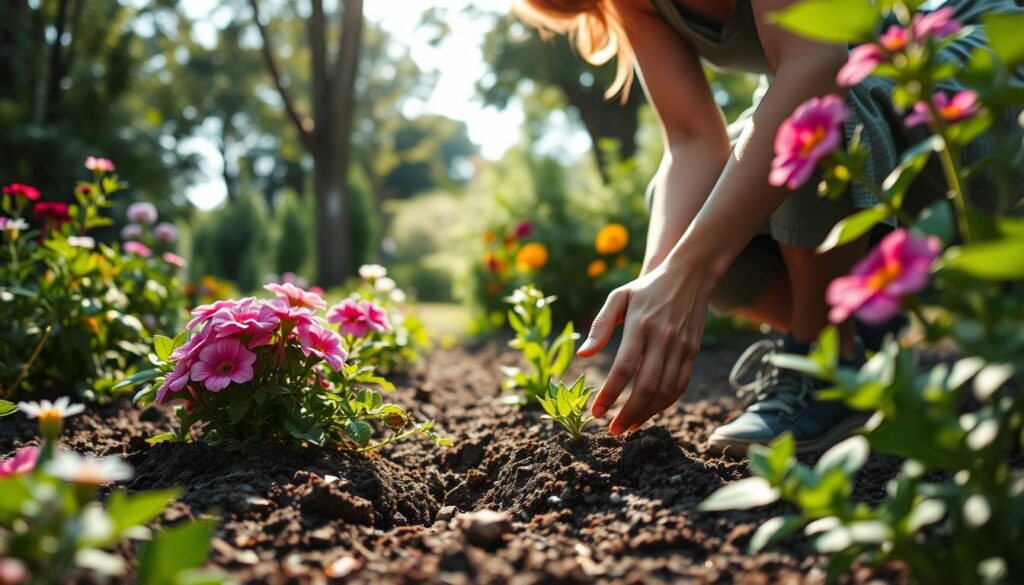
Mindfulness in gardening is not just sitting there. It’s about actively engaging with the world around us. Studies show big mental health benefits from this:
- 20% higher mindfulness levels among weekly gardeners
- 30-40% less depression and anxiety
- More endorphins released, like from exercise
The Art of Observation
Observation is key in mindful permaculture. Watching plants grow helps gardeners become more aware. Seeing seeds sprout, tracking leaves, and understanding nature are calming and clear the mind.
“Nature puts the mind in a state similar to meditation” – Clare Cooper Marcus
Grounding Techniques in Permaculture
| Technique | Mental Health Benefit |
|---|---|
| Slow, intentional gardening movements | Reduces stress, increases present-moment awareness |
| Breathing with plant rhythms | Lowers cortisol levels, promotes relaxation |
| Sensory engagement with soil | Enhances emotional regulation, grounds energy |
By adding mindfulness to gardening, people can make their outdoor spaces better for mental health. They create lasting bonds with themselves and nature.
Stress Reduction Through Engagement with Nature
Permaculture is a great way to handle stress and boost mental health. It uses eco-therapy to connect us with nature. This approach offers a healing experience that traditional methods can’t match.
Studies show a strong link between nature and stress relief. They highlight how permaculture can change our mental health for the better:
- Gardening can lower cortisol levels by up to 25%
- Being outdoors reduces anxiety a lot
- Nature helps our minds recover
Natural Settings and Stress Response
Permaculture environments offer special benefits for our minds. Being around green spaces triggers good brain responses. It helps us get away from city stress and find natural peace.
“Nature itself is the best physician” – Hippocrates
The Role of Hands-On Activities
Working with soil, plants, and nature is a great way to reduce stress. Gardening releases happy hormones, boosts confidence, and gives a sense of achievement. These feelings help fight off bad emotions.
Creating Safe Outdoor Spaces
Creating peaceful outdoor areas is key in permaculture. By planning carefully, we can make spaces that help our mental health. These areas offer a calm escape from everyday stress.
Fostering Creativity and Problem-Solving Skills
Permaculture is a special way to live sustainably. It turns regular places into creative problem-solving spots. Gardeners and designers use environmental psychology to tackle challenges with new ideas and flexible plans.
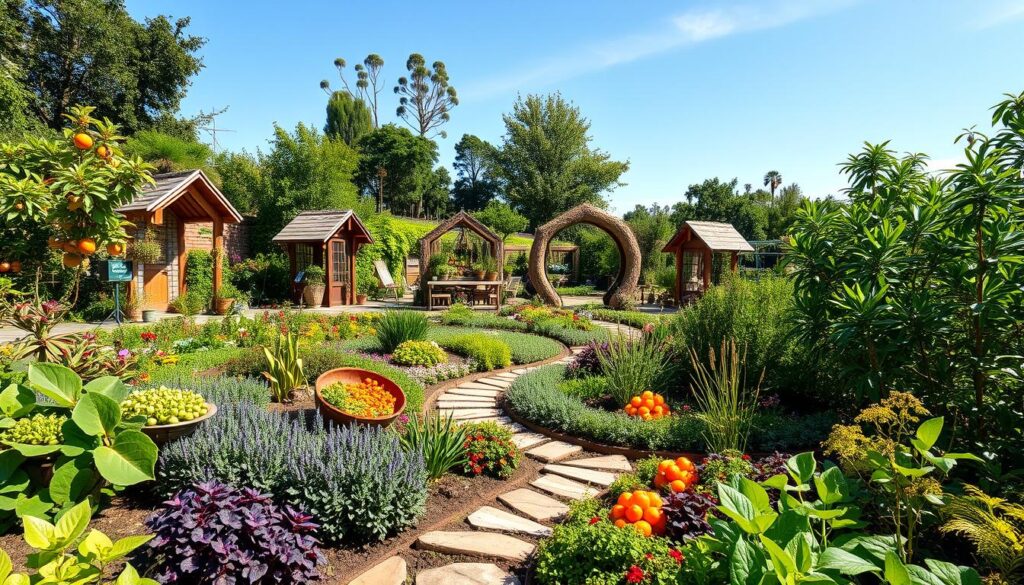
In permaculture, creativity is more than just gardening. It’s about finding intelligent design solutions that fit with nature. Every problem is a chance to think differently.
Innovative Solutions in Permaculture
Good permaculture design means thinking differently. Designers need to:
- Watch natural patterns
- Get how ecosystems work together
- Find solutions that do many things at once
The Role of Trial and Error
“In permaculture, mistakes are not failures but valuable learning experiences that contribute to resilient design.” – Permaculture Design Handbook
Trying and failing is key to solving problems. By learning about soil bacteria and ecosystems, people get better at adjusting and improving their plans.
Creativity in Design
| Design Approach | Creative Strategy | Potential Outcome |
|---|---|---|
| Vertical Gardening | Maximize Small Spaces | Increased Food Production |
| Water Harvesting | Capture and Redirect Resources | Reduced Water Consumption |
| Companion Planting | Natural Pest Management | Decreased Chemical Intervention |
Permaculture sees challenges as chances for creative problem-solving. Being flexible and observant helps people grow skills that go beyond gardening. These skills are useful for living sustainably in many ways.
Developing a Sense of Purpose and Accomplishment
Permaculture is more than just growing food. It’s a journey to personal growth and building resilience. Through nature-based therapy, people find ways to boost their self-confidence and reach their goals.
Growing your own food gives you a special feeling of accomplishment. Every seed you plant is a step on your personal journey. It teaches you patience, dedication, and the joy of hard work paying off.
Personal Growth through Gardening
Gardening in a permaculture system is like growing yourself. Just as plants need care, so do our skills and emotional strength. Your garden is a place where you learn in a natural way.
- Develop mindfulness through careful observation
- Learn problem-solving skills by adapting to natural challenges
- Build confidence through successful plant cultivation
Setting and Achieving Goals
Permaculture teaches you to set goals wisely. Gardeners learn to break big tasks into smaller steps. This skill helps in both personal and professional life.
| Permaculture Goal | Personal Development Outcome |
|---|---|
| Seed Selection | Strategic Planning |
| Soil Preparation | Creating Strong Foundations |
| Continuous Monitoring | Adaptability and Patience |
The Reward of Harvesting
“In every seed lies the potential for transformation, both in gardens and in ourselves.” – Permaculture Wisdom
Harvesting is the greatest reward of nature-based therapy. When you pick the vegetables you’ve grown, you feel an unmatched sense of pride. It boosts your mental health and self-worth.
Education and Lifelong Learning in Permaculture
Permaculture offers a unique pathway to continuous learning and personal growth. It goes beyond traditional gardening. It creates an immersive educational experience that connects individuals with sustainable living principles.
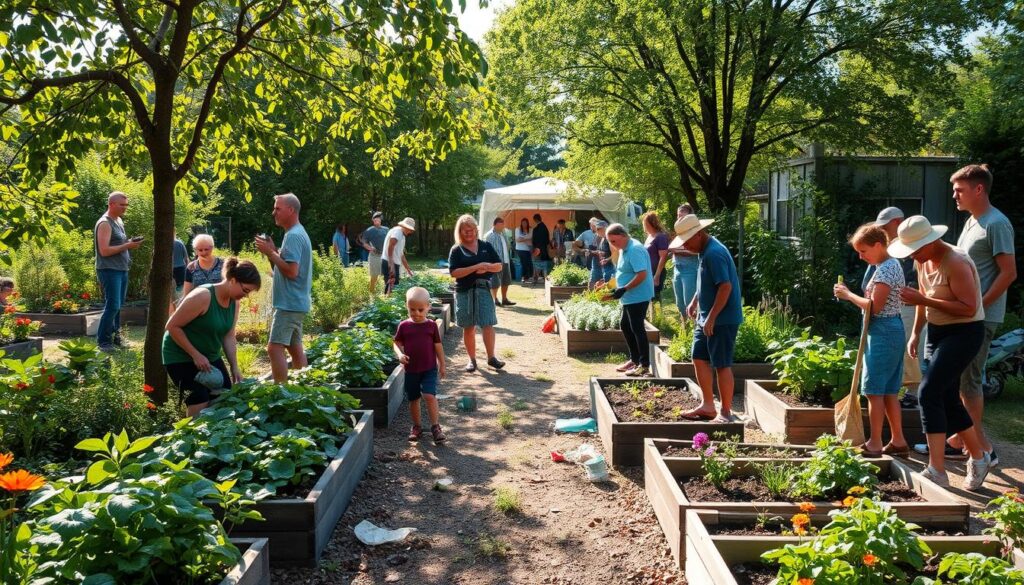
Skills Developed Through Practice
Engaging in community gardening benefits participants by developing a wide range of practical and cognitive skills. Learners can acquire knowledge in:
- Ecological systems thinking
- Sustainable food production techniques
- Natural resource management
- Design and problem-solving strategies
Workshops and Community Classes
Permaculture education creates powerful learning opportunities through collaborative experiences. Local workshops provide hands-on training. This transforms theoretical knowledge into practical skills.
| Learning Outcome | Percentage of Improvement |
|---|---|
| Student Environmental Engagement | 85% |
| Teamwork Skills | 55% |
| Interest in Environmental Careers | 50% |
Learning from Nature
Sustainable living education through permaculture teaches individuals to observe and interact with natural systems. Nature becomes the ultimate classroom. It offers profound lessons in resilience, adaptation, and interconnectedness.
“In permaculture, every challenge is an opportunity to learn and grow.” – Bill Mollison
By embracing lifelong learning through permaculture, individuals can develop a deeper understanding of ecological systems. They also enhance their mental well-being and connection to the environment.
Connection to Food Sources and Sustainability
Permaculture changes how we see food production. It helps us connect more deeply with our food and live sustainably.
The world’s food system is facing big problems. With 10 billion people expected by 2050, we need sustainable food. Permaculture offers new ways to solve these issues with its design and holistic views.
Understanding Food Systems
Permaculture changes our view of food production. It uses several key principles:
- Promoting local food production
- Reducing environmental impact
- Enhancing nutritional diversity
- Supporting community resilience
The Impact of Local Food Production
Local food production through permaculture has many benefits:
- Reduces transportation emissions (currently 19% of food emissions)
- Increases nutritional value of crops
- Supports community food security
- Minimizes reliance on industrial agriculture
Teaching Sustainable Practices
“Permanent agriculture is not just about growing food, but cultivating a sustainable relationship with our environment.”
Permaculture education teaches us to make better food choices. It shows us how soil health, biodiversity, and nutrition are connected. This helps us build more sustainable food systems.
Studies show permaculture can lower stress, offer exercise, and boost self-esteem. It also teaches us to care for the environment.
The Benefits of Biodiversity on Mental Well-Being
Biodiversity is key for our mental health and understanding of nature. Studies show that diverse ecosystems give us deep psychological benefits. They connect us to the complex world of natural life.
Recent studies show a strong link between biodiversity and our mental health. A study from King’s College London found that areas rich in native plants boost our mental health for up to 8 hours.
Varied Plant Life and Mental Stimulation
Diverse plant environments are amazing for our minds. They offer us sensory experiences that:
- Reduce stress levels
- Boost our thinking skills
- Help us manage our emotions
- Make us more resilient
The Importance of Pollinators
Pollinators are vital in biodiverse ecosystems. They help our environment and bring us joy through watching their work.
“Nature’s complexity is a profound source of mental restoration and healing.” – Environmental Psychology Research Group
Creating Habitats for Wildlife
Creating homes for wildlife is good for our mental health. It makes us feel connected and gives us a sense of purpose. It helps our environment and our minds grow.
| Habitat Element | Mental Health Benefit |
|---|---|
| Native Plant Diversity | Reduces stress, enhances cognitive function |
| Pollinator Gardens | Increases mindfulness, promotes environmental awareness |
| Wildlife Observation Areas | Supports emotional regulation, reduces anxiety |
By embracing biodiversity, we can make mental health sanctuaries. These places help our ecological and psychological well-being.
The Role of Permaculture in Climate Resilience
Climate change is a big challenge for our planet. Permaculture helps people and communities adapt and grow in these changing times.
Permaculture uses sustainable living to solve environmental problems. It teaches us to work with nature in a holistic way. This helps us build stronger, more adaptable systems.
Empowering Individuals in Climate Action
Permaculture gives people the power to fight climate change. It teaches us to:
- Save water
- Grow diverse and strong food systems
- Make less carbon by eating local
- Use land in a way that regenerates it
Adapting to Environmental Changes
Permaculture systems are flexible and can handle environmental changes well. Studies show that permaculture can make crops 30% more productive. It also boosts the variety of life in ecosystems.
| Permaculture Strategy | Environmental Impact | Resilience Benefit |
|---|---|---|
| Diverse Planting | Increases Pollinator Diversity by 40% | Enhanced Ecosystem Stability |
| Composting | Reduces Household Waste by 30% | Waste Reduction |
| Urban Farming | Space-Efficient Food Production | Local Food Security |
Long-Term Sustainability and Mental Health
Permaculture is great for our mental health. Studies show that 65% of people feel better when they get involved in sustainable projects.
“Permaculture is not just about growing food, but about growing hope and resilience in the face of environmental challenges.” – Permaculture Design Expert
By working on regenerative systems, we find purpose. We help protect the environment in a meaningful way.
Exploring the Spiritual Aspects of Permaculture
Permaculture is more than gardening. It’s a way to connect deeply with nature and grow personally. It uses nature-based therapy to help people explore their inner selves.
This approach to permaculture goes beyond just gardening. It creates experiences that change lives and help the planet. Studies show that gardening mindfully can greatly improve mental health.
Nature as a Spiritual Retreat
Gardens are special places for quiet thought. They offer a chance to reflect deeply. This involves:
- Creating spaces for meditation
- Connecting with nature’s rhythms
- Watching how nature works together
Reflection and Contemplation in Gardens
“In every walk with nature, one receives far more than he seeks.” – John Muir
Permaculture gardens are places for growth. People find deep insights by paying attention to their surroundings.
The Intersection of Ecology and Spirituality
| Spiritual Practice | Ecological Benefit | Personal Impact |
|---|---|---|
| Mindful Gardening | Soil Regeneration | Stress Reduction |
| Ecosystem Observation | Biodiversity Support | Enhanced Awareness |
| Collaborative Design | Sustainable Practices | Community Connection |
Permaculture through nature-based therapy offers a complete way to wellness. It cares for both our inner selves and the world around us.
Encouraging Generosity and Sharing Resources
Permaculture is more than just gardening. It builds strong community ties and encourages sharing. It turns individual gardens into hubs for everyone’s well-being, showing the power of giving and being connected.
At the heart of community gardening is making friends. Permaculture teaches us to share what we have, like food and knowledge. This creates a world where everyone helps each other.
Community Gardens and Food Sharing
Community gardens are places of kindness. They become places where people come together. Here, they:
- Share fresh, locally grown produce
- Exchange gardening techniques
- Build neighborhood relationships
- Reduce food insecurity
Building a Culture of Generosity
Permaculture does more than grow food. It teaches us to see the world as full of abundance. This mindset lowers stress and makes communities stronger.
| Generosity Aspect | Psychological Impact |
|---|---|
| Food Sharing | Increased Social Connection |
| Knowledge Exchange | Enhanced Self-Esteem |
| Resource Collaboration | Reduced Individual Stress |
User-Friendly Permaculture Models
Accessible generosity is crucial for spreading permaculture. Simple, easy-to-follow models help communities adopt gardening practices. These practices improve mental health and bring people together.
“In permaculture, we don’t just grow food; we grow connections.”
Empowering Youth Through Permaculture Education
Permaculture education is a new way to help young people grow. It mixes learning about the environment with doing things hands-on. Schools can use eco-therapy to help kids connect with nature and learn important life skills.
Getting kids involved in permaculture has many benefits. Studies show that nature activities can make kids happier and healthier.
Curriculum Integration Strategies
- Develop school gardens as living classrooms
- Create project-based learning experiences
- Implement environmental psychology concepts
- Design age-appropriate eco-therapy modules
Youth Leadership Development
| Project Type | Leadership Skills Developed | Psychological Benefits |
|---|---|---|
| Community Garden Projects | Collaboration | Increased Self-Confidence |
| Ecological Restoration | Problem-Solving | Enhanced Critical Thinking |
| Sustainable Design Challenges | Innovation | Improved Creativity |
Engagement and Mental Well-Being
Research shows kids who work on environmental projects grow a lot. They can learn about nature by up to 50% and feel more connected to their community.
“Empowering youth through permaculture is not just about gardening—it’s about cultivating future environmental stewards.” – Environmental Education Expert
By using permaculture education, schools can offer a complete learning experience. This experience helps kids grow as individuals and care for the environment together.
The Future of Permaculture and Psychological Well-Being
Permaculture is changing how we think about mental health and nature. It’s a way to improve well-being by connecting with the environment. Sustainable design is key to this, showing how nature and human needs can work together.
Studies are showing that permaculture can really help our mental health. It’s not just about growing food; it’s about building strong communities and healing spaces.
Experts are starting to see the value of permaculture in mental health. It’s a way to fight the growing problem of mental illness. By working with nature, we can heal ourselves and our communities.
Trends in Permaculture Practices
Permaculture is getting more popular, thanks to its focus on community and the environment. New designs are being created to support both people and nature. This shows a bright future for permaculture.
Long-Term Mental Health Benefits
Research keeps showing that permaculture is good for our minds. People who practice it feel less stressed and more connected. It gives them a sense of purpose.
Policy Implications and Advocacy
More people are now seeing permaculture as a solution to mental health issues. It’s a way to heal ourselves and our planet. Advocates are working hard to make it a part of our healthcare system.

